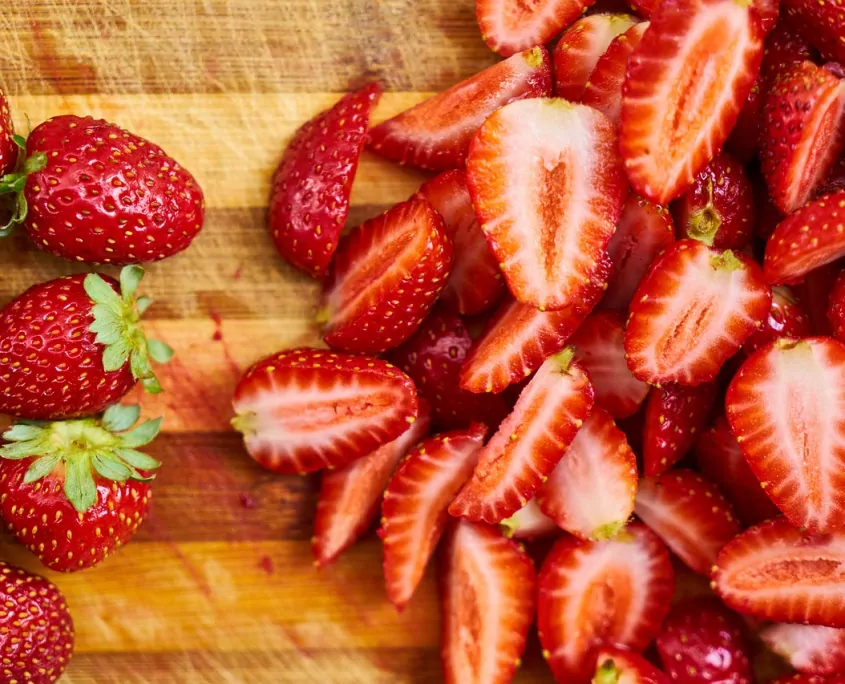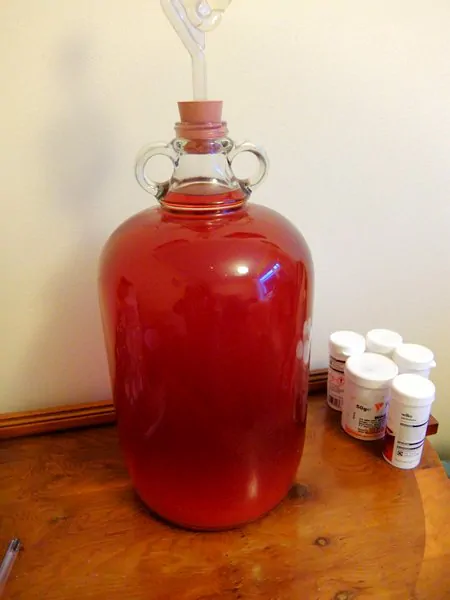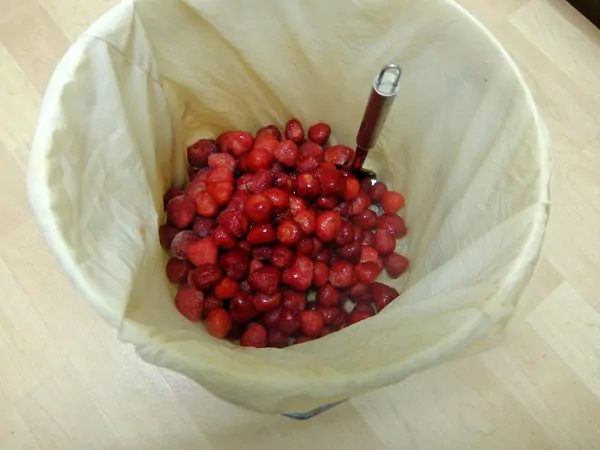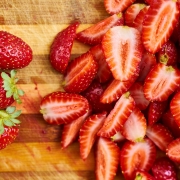Strawberry Wine Recipe: The Only Recipe You’ll Ever Need

Strawberries are one of my favourite fruits, how can you capture that taste in a strawberry wine recipe?
With any fruit wine recipe, the main flavour you want to really shine is the fruit you are using and sometimes it is tough to find that balance. It is more difficult than you think to capture that strawberry aroma in wine because it is so delicate.
This Strawberry wine recipe finds that balance with the delicate flavour of fresh strawberries tuned in with a crisp and slightly dry wine.
There isn’t lots of body to this strawberry wine but it is most definitely refreshing, and crisp and the strawberries shine through right until the last drop.
Table of Contents
Delicious Strawberry Wine

Strawberries have to be one of the most popular choices for fruit wine. I don’t know of many people who don’t like eating strawberries and I think this turns into a desire to translate this into a wine recipe.
If you grow your own strawberries you will be able to harvest them and freeze them until you have enough to make this wine. Pick your own farms or when they are on sale in the shops is the alternative for getting a glut for making wine.
In the UK in the summer the shops are full of strawberries, supermarkets buy them by the pallet load and you can generally pick and choose what varieties you may want to use in your strawberry wine recipe.
Fresh Strawberry Wine
When it comes to selecting your strawberries for wine it is a case of the riper the better. It’s most often the case that when you buy strawberries in a supermarket they are around 75 – 85% ripe this is because the shelf life of fully ripe strawberries is a lot shorter.
Once you pick a strawberry they do not ripen any further, they will colour more but won’t ripen and get sweeter. Using strawberries for your wine that are only 80% ripe can be fine but there are other options to get sweeter strawberries.
Pick your own farms will give you the option to select fruit that is completely ripened, you have the choice of picking exactly the strawberries you want.
This means that you can quality control each and every strawberry that will go in your strawberry wine and you can go from picking to processing the strawberries in a matter of hours.
Frozen Strawberry Wine
Another option is to use frozen strawberries, the great thing about frozen strawberries is they are most often picked when they are riper as they are frozen quickly after picking they won’t degrade on the shelf at the shop. The other thing with frozen strawberries is they are usually already prepared with the green part removed and often they’re cheaper than the fresh.

In this strawberry wine recipe, I have used frozen strawberries although it’s completely fine if not better to use fresh, ripe fruit.
I’m making this in winter so fresh strawberries are not in season. One thing I will mention about freezing is that when the fruit is frozen it breaks down the cells when you defrost the strawberries the juice pretty much runs out of the fruit which is great for making wine. The first thing we will be doing in this recipe is mashing the berries to break them up.

Making Strawberry Wine
To make this strawberry wine you’ll need the following piece of equipment which you can pick up here if you don’t have it already:
- Fermenting Bucket
- Nylon Straining Bag
- 1 Gallon Demijohn
- Bung & Airlock
- Potato Masher
- Hydrometer
- Syphon
- Bottles, Corks and Corker
Strawberry Wine Recipe Ingredients – Makes 4.5 litres / 1 gallon
- 1.8 kg Strawberries
- 1 kg Sugar
- 4 litres Water
- 1 Campden Tablet
- 1 tsp Acid Blend
- 1 tsp Yeast Nutrient
- 1/2 tsp Pectic Enzyme
- 1/8 tsp Tannin
- 1 sachet Champagne Yeast / Lalvin EC-111
Strawberry Wine Recipe Method
- Begin by boiling the water and sugar together, ensuring the sugar is fully dissolved. Once at a boil turn off the heat.
- If you are using fresh strawberries prepare them by removing the stems and washing them, pick through and remove any bad fruit.
- Place the nylon straining bag into the fermenting bin, add the prepared strawberries and begin mashing with a clean, sanitised potato masher. The idea is to break up the strawberries as much as possible, releasing the juice and colour.
- Pour the boiled sugar and water solution over the strawberries and mix everything together. Allow to cool and then add the acid blend, yeast nutrient, tannin, and Campden tablet. Put the lid on the fermenter with an airlock and leave for 12 hours.
- After 12 hours add the pectic enzyme, mix, and leave for 24 hours.
- After 24 hours add the yeast to begin fermentation. Allow fermentation to go on for a week and stir once every one or two days, this helps extract as much flavour from the fruit as possible which will have the tendency to float.
- After a week lift out the straining bag with the pulp and allow to drain as much as possible, avoid squeezing the bag.
- Take a hydrometer reading, if the wine is below 1.010 specific gravity rack the wine into a sanitised demijohn. If not leave for a further few days and check the gravity again. Once racked attach a bung and airlock and leave.
- Wait for at least 2 months or more and the wine can then be racked off the sediment. You can wait for the strawberry wine to completely clear before racking to a new vessel. After this either let it age further for a few months or bottle it. If you wish to back-sweeten the wine stabilise and follow this advice here.
- This strawberry wine is best kept for a few months and up to a year.




one thing rubber bungs can taint the wine if the wine become very active and fermentation reaches them, best to pulp the strawberries with a mixer , prior to putting into muslin bag or pulp in fermenting bucket and strain through muslin bag later ( nearly put in muslim bag ) lucky i checked
When do you pull out the Nylon bag?
#7 After a week lift out the straining bag with the pulp and allow to drain as much as possible, avoid squeezing the bag.
Hello there! I started this recipe about a week and a half ago–only the second batch of wine I’ve made. I followed every word down to the letter, but something must have gone wrong.. After its week with the yeast, my hydrometer read in-between 1.0 and 0.9, and when I siphoned it into my demijohn, the airlock doesn’t exhibit any bubbling. My first batch of wine is sitting next to it, and gives a chipper little bubble every few seconds, which this batch appears…dead? I tasted a small sample before transferring it (as I did with my peach wine), and it was VERY tart, yeasty, and bitter. No sweetness at all. Not vinegary, but not at all sweet. In contrast, my peach was very sweet (as well as yeasty) to the taste. Please help! I am distraught..
If your hydrometer reading is between 0.990 and 1.000 then there is no sugar left to ferment. The yeast has already consumed all the sugar so will not produce any more carbon dioxide. It may be that the airlock was not fitted correctly so the gas escaped without bubbling.
Try not to worry, allow the wine to condition, the yeast are still working, cleaning up the byproducts of fermentation which will remove that bitterness and astringency. It sounds like the tartness you are describing may be that the wine is too dry for you. You can back sweeten the wine to your liking before bottling following this guide.
Try not to worry and have patience, the wine will improve with time.
This happened to mine too. I racked it off the sediment and put in to clean demijohns. It seems to not bubble at all anymore? What should I do, please help as this is my first attempt? Thanks
If you racked it to a new demijohn and the activity stopped this is fine. It indicates that the majority of the sugars have fermented out. The yeast will continue to work and then eventually drop to the bottom of the vessel.
Can add campden tablets when moving the to carboy I added this in the first step now when I move should I add more.
You can add Campden tablets when transferring to limit oxidation. I would suggest half a tablet it enough.
I accidentally added the Pectic Enzyme during the first stage (first 12 hours) will that hurt the outcome of my wine brewing?
It should be fine, the pectic enzyme helps break down the fruit and prevents haze. It will still be working.
In a word no. Pectin enzyme [pectolase] converts PECTIN into sugars and assists in clearing you wine or cider. So far I’ve noit had to use any FININGS for either. When making fruit wines it’s recommended that enzyme is used at the ititial starter stage but I am of the opinion that it make little difference as long as it’s added during fermentation.
I did this recipe and made it for 3 gallons, for some reason my yeast won’t start, I may have rushed the yeast by 10 hours or so but other than that followed directions, I re pitched yeast yesterday, hoping something happens. Its been 60 hours and no signs of starting.
Hopefully, by repitching yeast, you will have started fermentation. Pitching yeast too close to adding the Campden tablet may cause problems so this may be the problem.
I scaled this up to five gallons. With the amount of fruit required, I could only get amount about 3 gallons of water into my primary fermentation bucket. Is there any harm in adding the additional liquids at the stage that I pull the bag with the fruit?
The issue you may encounter, is the concentration of sugar at the beginning of fermentation is really high and this will stress the yeast. If you add less liquid at the start you will want to add less sugar, then when you are ready to top up the fermenter add the rest of the water and sugar together.
Hope this makes sense.
Hi there, I would like to use this recipe for a 5 gallon batch. Could you advise on the correct amount for ingredients or how to scale up the current recipe? Thanks
Scale up all the ingredients by 5 so instead of 1 gallon multiply by 5. One yeast sachet should be fine so you can just proceed with one packet. Hope this helps.
But if your Carboy is a let’s say a 1 Gallon used wine bottle after adding sugar & 1 gallon of water don’t be tempted to overfill the secondary fermenter Carboy. 1 gallon is 1 gallon
I am currently experimenting with aging with various wood chips to add tannins. Tweaking this recipe by excluding the tannins up front and aging with cherry wood.
(Currently aging a cyser with JD Bourbon barrel oak chips.)
This strawberry wine is only my 3rd ferment, but I am learning a lot as I go.
Best of luck Stephen. Sounds great!